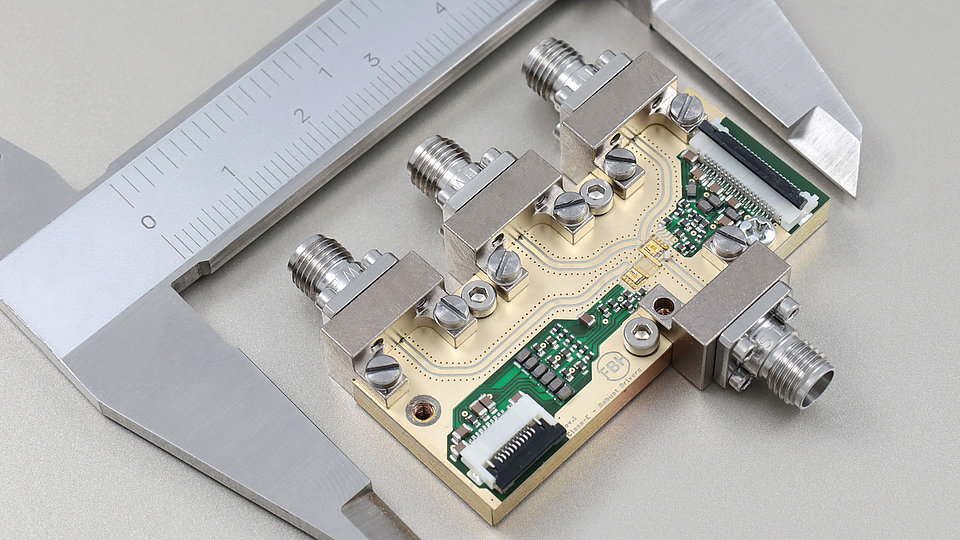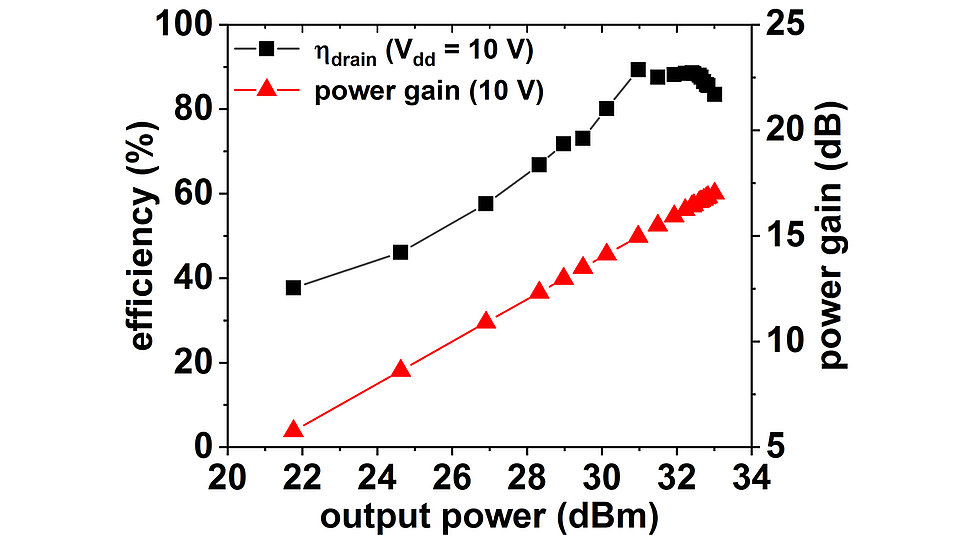A 4 GHz digital class-E outphasing PA for highly efficient 5G base stations
Modern 5G/6G wireless systems have to cope with steadily increasing data rates and require more complex modulation schemes as well as spectrally efficient signals with a high peak-to-average power ratio (PAPR). The design of energy-efficient transmitter architectures in microwave radios has therefore become more challenging than ever. All-digital RF transmitters gain more and more importance in this context. However, the power-added efficiency of power amplifiers (PAs) is still a bottleneck. The PA is the major power dissipation contributor in the front-end, thus significantly affecting the overall efficiency. At this point, the switch-mode class-E approach has been the preferred solution, but mostly limited with respect to peak power operation. Combining this technique with the outphasing concept, however, can overcome these limitations.
Recently, we have presented the first GaN-based digital class-E outphasing power amplifier module for 5G base station applications in the 4 - 6 GHz range. This amplifier consists of two digital GaN PA MMICs with a 4:1 size ratio between the final-stage transistor gate-widths. The amplifier chips follow a compact digital layout approach without any reactive matching to provide broadband operation and flexibility in terms of signal frequency. The frequency of operation can easily be changed by adjusting the output network, which is a major advantage compared to usual class-E designs. Both MMICs have been fabricated with FBH’s 0.25 µm GaN-HEMT process. A bond-wire-based load network shapes the typical class-E waveform characteristics and combines the two outputs for outphasing at 4 GHz in order to maximize efficiency at power back-off.
At 4 GHz a maximum output power of 8.4 W and a power gain of 23 dB were reached for a final-stage drain supply voltage Vdd of 27 V. Peak final-stage drain efficiencies of 84% and 38 % were achieved for a Vdd of 10 V at 0 dB and 11.2 dB back-off, respectively. For the same supply voltage, applying a modulated 20 MHz LTE signal with an encoded PAPR of 6.5 dB the digital class-E outphasing PA achieves a final-stage drain efficiency of 41%. Furthermore, an error vector magnitude of 5.3% as well as an adjacent channel power ratio of more than 40 dB prove a good linearity. Due to its flexibility regarding digital input and operation modes (pulse-width modulation, outphasing, switching-off one PA), the proposed power amplifier module is a promising candidate to reduce energy consumption in 5G base stations.
This work was funded by the German Research Foundation (DFG) under ref. WE 6288/3-1. It was additionally supported by the German Federal Ministry of Education and Research (BMBF) within the “Research Fab Microelectronics Germany (FMD)” framework under ref. 16FMD02.
Publication
T. Hoffmann, L. Schellhase, W. Heinrich, A. Wentzel, "A 4 GHz GaN-based Digital Class-E Outphasing PA", IEEE/MTT-S International Microwave Symposium (IMS) Digest, pp. 622 - 625, Denver, CO, USA (2022).

